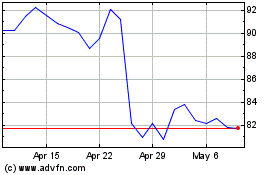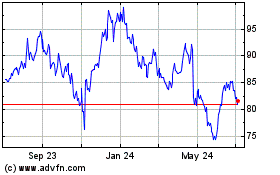BioMarin Pharmaceutical Inc. (NASDAQ:BMRN) today announced data
analysis for Kyndrisa demonstrating consistent evidence of efficacy
in comparable patients across three randomized, placebo-controlled
studies that were conducted contemporaneously. Kyndrisa is
currently under review with U.S. and European health authorities
for the treatment of patients with Duchenne muscular dystrophy who
are amenable to exon 51 skipping. This analysis is included
in materials prepared by BioMarin for the November 24, 2015
Peripheral and Central Nervous System Drugs Advisory Committee
(PCNS) meeting and can be found on the FDA website at:
http://www.fda.gov/AdvisoryCommittees/Calendar/ucm467180.htm
The analysis examined the pooled study
population from the three placebo-controlled studies to identify
patients whose baseline characteristics were comparable among all
three studies with respect to two key baseline predictive factors:
6-minute Walk Distance (6MWD) and Rise From Floor (RFF). The goal
of the evaluation was to determine whether results in comparable
populations from the three studies all conducted contemporaneously
were consistent with one another.
The treatment effect at week 48 for the pooled
population of 128 study subjects from the three studies
representing the middle 50% of all subject patients baseline 6MWD
(between 313 meters and 419 meters) was 31.3 meters (p < 0.01).
The treatment effect at week 48 for the pooled population of
125 study subjects from the three studies representing the middle
50% of all subject patients baseline RFF (between 4.2 seconds and
13.3 seconds) was 25.8 meters (p = 0.015).
This analysis shows that the results of study
044 are consistent with the results of the two other studies and
provides support for those two randomized studies. In
patients who are comparable to each other, similar outcomes have
been documented in and across all three studies.
“This analysis contributes important insights
into understanding the results of the three studies that serve as
the basis for the Kyndrisa application,” commented Hank Fuchs,
M.D., Chief Medical Officer of BioMarin. “With the results of this
analysis the late stage Kyndrisa clinical program can be summarized
as consisting of 3 well controlled randomized studies with over 500
patient years of safety data where the efficacy results include one
statistically significant study on an established clinical endpoint
with p= 0.01 (study 117), one supportive study with p= 0.07 (study
876) and one study (study 044) in which patients who are comparable
to patients in the other two studies have similar results. We look
forward to the opportunity to review in great detail the evidence
of effectiveness based on this pooled data analysis at our Advisory
Committee meeting.”
POOLED ANALYSIS DETAILS:
To enable comparison across studies, a group of
patients enrolled in each of the 3 studies was identified based on
similar baseline 6MWD and baseline RFF across the pooled
population. The entire range of baseline characteristics for both
6MWD and RFF was examined, and the middle 50% of subjects from
these analyses of the pooled population were selected for analysis.
This approach removes the 25% most severely affected and the 25%
least severely affected subjects from the analysis, and includes a
sufficient sample size between treatment groups to enable
interpretable results.
Based on this selection criterion, subjects had
either a baseline 6MWD between 313 to 419 meters or a RFF between
4.2 and 13.3 seconds. Using these two groupings of subjects, the
treatment effect was analyzed in the pooled study population, and
by each study individually. These analyses show that improvement in
6MWD observed in the pooled population is similar as in the 044
study. This result is true for populations defined by either
baseline 6MWD (Table 1) or baseline RFF (Table 2). Parameter
estimates, 95% confidence intervals, and nominal p-values are
provided for descriptive purposes.
Table 1. Treatment Effect at Week 48 in
6MWD By Study and Pooled in Subjects from Studies 117, 876, and 044
with Baseline 6MWD between 313 meters and 419 meters
|
|
Study |
|
|
Pooled044/117/876(N=76/52) |
Study 044(N=56/32) |
Pooled117/876(N=20/20) |
Study 117 (N=8/13) |
Study 876 (N=12/7) |
|
Mean difference (meters) Kyndrisa vs. Placebo |
|
31.3 |
|
19.9 |
|
55.6 |
|
|
72.8 |
|
37.1 |
|
95% CI |
|
(9.3, 53.2 |
) |
(-8.8, 48.7) |
|
(19.8, 91.3 |
) |
|
(12.4, 133.1 |
) |
(-5.0, 79.2) |
|
P value |
|
0.006 |
|
0.171 |
|
0.003 |
|
|
0.021 |
|
0.080 |
Note: For pooled analysis, model includes study
ID, treatment, visit, treatment by visit, baseline 6MWD, baseline
6MWD by visit. For analysis within each study, model includes
treatment, visit, treatment by visit, baseline 6MWD, baseline 6MWD
by visit. N’s are presented as 6 mg/kg drisapersen/placebo.
Table 2. Treatment Effect at Week 48 in
6MWD By Study and Pooled in Subjects from Studies 117, 876, and 044
with Baseline RFF between 4.2 seconds and 13.3 seconds
|
|
Study |
|
|
Pooled044/117/876(N=79/46) |
Study 044(N=58/28) |
Pooled117/876(N=21/18) |
Study 117(N=10/12) |
Study 876(N=11/6) |
|
Mean difference (meters) Kyndrisa vs. Placebo |
|
25.8 |
|
18.1 |
|
36.6 |
|
31.4 |
35.6 |
|
95% CI |
|
(5.1, 46.6 |
) |
(-9.2, 45.6) |
|
(4.2, 69.0 |
) |
(-22.3, 85.1) |
(-3.1, 74.3) |
|
P value |
|
0.015 |
|
0.191 |
|
0.028 |
|
0.236 |
0.069 |
Note: For pooled analysis, model includes study
ID, treatment, visit, treatment by visit, baseline 6MWD, baseline
6MWD by visit. For analysis within each study, model includes
treatment, visit, treatment by visit, baseline 6MWD, baseline 6MWD
by visit. N’s are presented as 6 mg/kg drisapersen/placebo.
This analysis is not intended to provide
stand-alone statistically robust evidence of treatment benefit
observed in the 044 study. The purpose of the analysis is to
demonstrate that the strong findings in studies 117 and 876 are
consistent with the outcome of the 044 study when patients whose
baseline predictive characteristics are similar across all three
studies. Taken together, these data substantiate the efficacy
findings of studies 117 and 876.
The PCNS advisory meeting is scheduled for
November 24 at 8:00 a.m. to 5:30 p.m. EST. The briefing materials
and webcast information can be found on the FDA website at:
http://www.fda.gov/AdvisoryCommittees/Calendar/ucm467180.htm
The Prescription Drug User Fee Act (PDUFA)
action date for completion of FDA review of the Kyndrisa NDA is
December 27, 2015.
About Duchenne Muscular
DystrophyChanges in the dystrophin gene (mutations) that
lead to the near absence of dystrophin protein result in the most
severe form of dystrophin deficient muscular dystrophy, Duchenne
muscular dystrophy, also known as just Duchenne. Boys living
with Duchenne experience progressive muscle weakness, causing
serious medical complications including serious heart or
respiratory-related complications, resulting in death in early
adulthood.
Primarily affecting boys, Duchenne affects
approximately 1 in every 3,500-5,000 male children, making it the
most common fatal genetic disorder diagnosed in childhood.
There is currently no FDA approved therapy
designed specifically to treat Duchenne.
About Kyndrisa
and Exon SkippingKyndrisa is an antisense
oligonucleotide that induces exon skipping to provide a molecular
patch for dystrophin transcripts produced by certain mutated
dystrophin genes. Exons are the parts of a gene that contain
the instructions for generating a protein. In applicable cases,
skipping an exon near the mutation allows for the production of a
truncated but functional dystrophin protein.
About BioMarinBioMarin is a
global biotechnology company that develops and commercializes
innovative therapies for patients with serious and life-threatening
rare and ultra-rare genetic diseases. The company's portfolio
consists of five commercialized products and multiple clinical and
pre-clinical product candidates. For additional information, please
visit www.BMRN.com.
Forward-Looking StatementThis
press release contains forward-looking statements about the
business prospects of BioMarin Pharmaceutical Inc., including,
without limitation, statements about: expectations regarding the
FDA’s review of the Kyndrisa NDA; outcomes of FDA Advisory
Committee Meeting regarding Kyndrisa; the possible impact that the
post-hoc analysis described in this release may have on the
advisory committee members or the FDA; and the possible approval of
Kyndrisa. These forward-looking statements are predictions and
involve risks and uncertainties such that actual results may differ
materially from these statements. These risks and
uncertainties include, among others: the actual conduct and result
of the FDA advisory committee meeting; results and timing of
current and planned clinical trials of Kyndrisa; the content and
timing of decisions by the FDA, and other regulatory authorities
concerning Kyndrisa; and those factors detailed in BioMarin's
filings with the Securities and Exchange Commission, including,
without limitation, the factors contained under the caption "Risk
Factors" in BioMarin's 2014 Annual Report on Form 10-K, as amended,
and the factors contained in BioMarin's reports on Form
8-K. Stockholders are urged not to place undue reliance on
forward-looking statements, which speak only as of the date hereof.
BioMarin is under no obligation, and expressly disclaims any
obligation to update or alter any forward-looking statement,
whether as a result of new information, future events or
otherwise.
Kyndrisa™ is our trademark, and BioMarin® is a
registered trademark of BioMarin Pharmaceutical Inc.
Investors:
Traci McCarty
BioMarin Pharmaceutical Inc.
(415) 455-7558
Media:
Debra Charlesworth
BioMarin Pharmaceutical Inc.
(415) 455-7451
BioMarin Pharmaceutical (NASDAQ:BMRN)
Historical Stock Chart
From Mar 2024 to Apr 2024

BioMarin Pharmaceutical (NASDAQ:BMRN)
Historical Stock Chart
From Apr 2023 to Apr 2024
